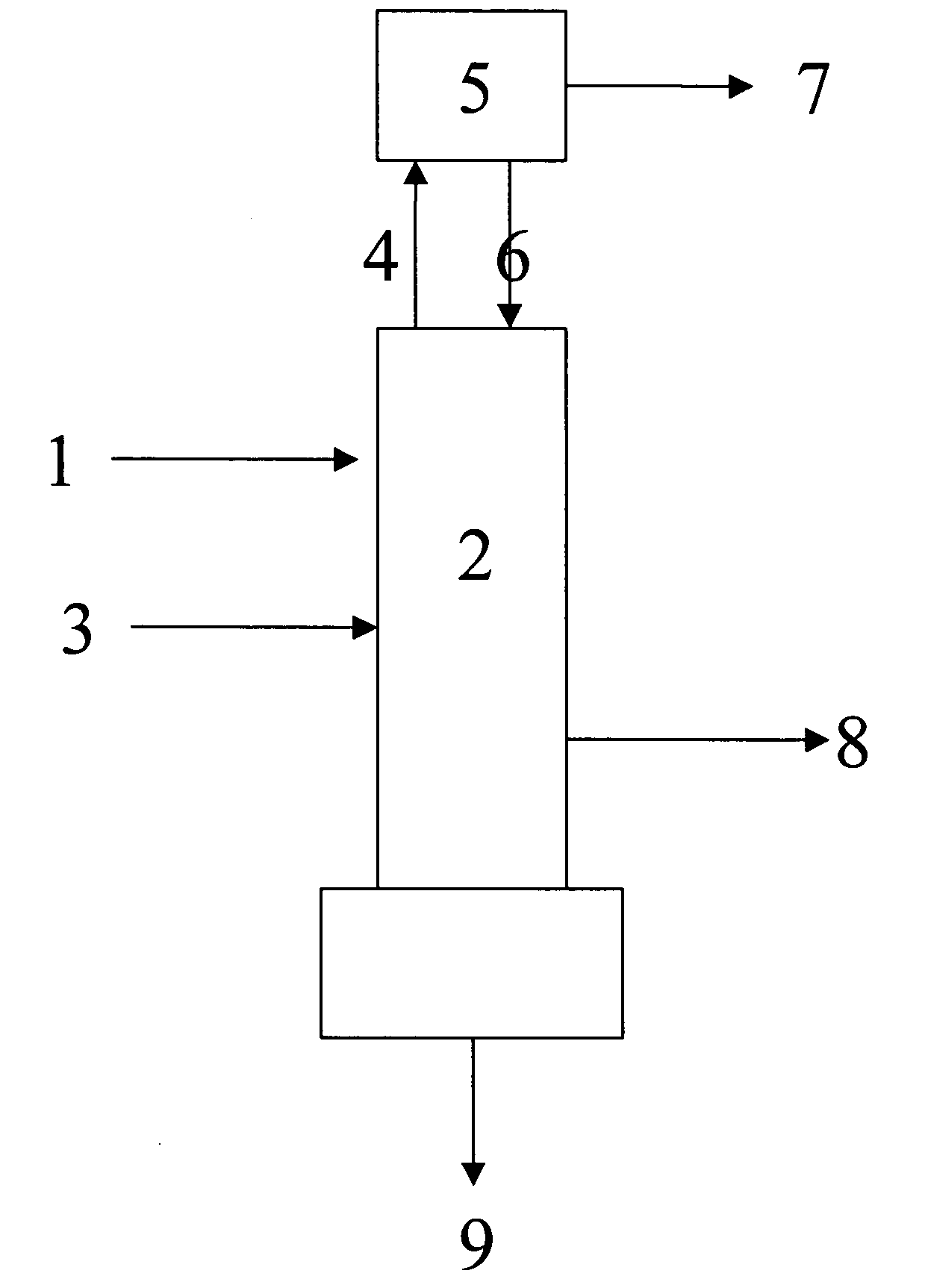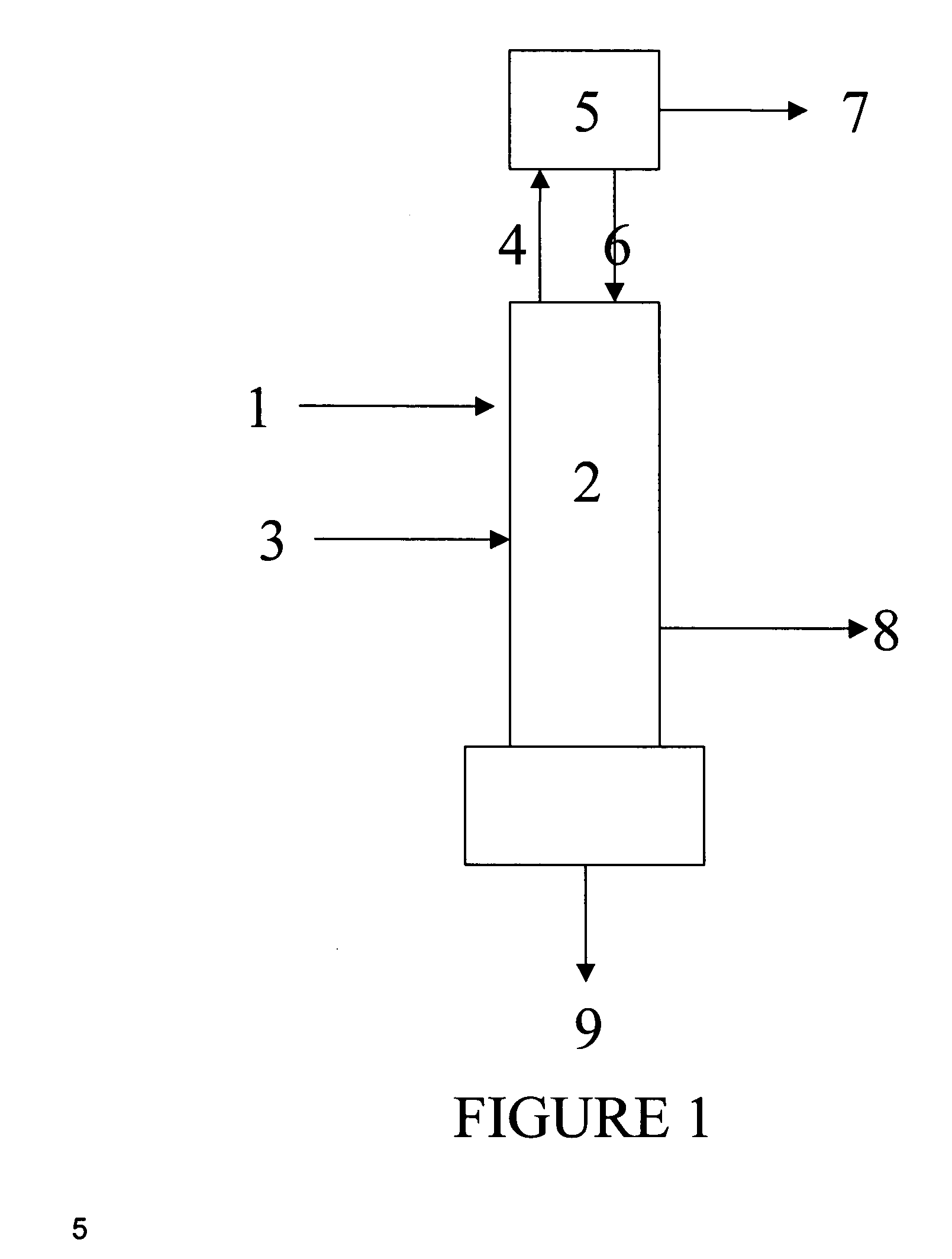Distillation process for reducing the concentration of dinitrogen difluoride and dinitrogen tetrafluoride in nitrogen trifluoride
a technology of dinitrogen and tetrafluoride, which is applied in the direction of distillation regulation/control, separation process, vacuum distillation separation, etc., can solve the problems of less information per device, large line width, and defect rate in the production of high-density integrated circuits
- Summary
- Abstract
- Description
- Claims
- Application Information
AI Technical Summary
Benefits of technology
Problems solved by technology
Method used
Image
Examples
example 1
[0036] This example is identical to comparative example 1, with the exception that a 4 pph sidedraw is removed from the distillation column at stage 35. The results of this distillation are shown in Table 3.
TABLE 3CASE NUMBER789# of Stages424242Crude Feed Stage303030Vapor Side-Draw Stage353535Column Top Temperature (° C.)−75−75−75Reflux Temperature (° C.)−75−75−75Distillate Temperature (° C.)−75−75−75Bottoms Temperature (° C.)−8−10−17Crude NF3 Feed Temperature (° C.)−60−60−60Top Pressure (psia)214.7214.7214.7Condenser Pressure (psia)214.7214.7214.7Bottoms Pressure (psia)216.7216.7216.7Overhead Takeoff Rate (PPH)96.1195.3893.26Reflux Rate (PPH)2000.002000.002000.00Bottoms Takeoff Rate (PPH)49.8950.6252.74Vapor Sidedraw Rate (PPH)4.004.004.00Crude NF3 FeedNF3 (PPH)99.7099.7099.70F116 (PPH)50.0050.0050.00N2F2-c (PPH)0.100.100.10N2F2-t (PPH)0.100.100.10N2F4 (PPH)0.100.100.10Overhead TakeoffNF3 (PPH)96.1195.3893.26N2F2-c (PPH)0.000000.000000.00000N2F2-t (PPH)0.000000.000000.00000Overhe...
example 2
[0040] This Example is identical to comparative example 3, except that there is now a 10 pph sided raw and the number of stages has been increased from 42 to 62. The results of this distillation may be seen in Table 5.
TABLE 5CASE NUMBER131415# of Stages626262Crude Feed Stage454545Vapor Side-Draw Stage505050Column Top Temperature (° C.)−75−75−75Reflux Temperature (° C.)−75−75−75Distillate Temperature (° C.)−75−75−75Bottoms Temperature (° C.)−8−8−8Crude NF3 Feed−60−60−60Temperature (° C.)Top Pressure (psia)215215215Condenser Pressure (psia)215215215Bottoms Pressure (psia)217217217Overhead Takeoff Rate (PPH)98.8694.5389.98Reflux Rate (PPH)5000.005000.005000.00Bottoms Takeoff Rate (PPH)4991.144995.475000.02Vapor Sidedraw Rate (PPH)10.0010.0010.00Crude NF3 FeedNF3 (PPH)99.7099.7099.70F116 (PPH)5000.005000.005000.00N2F2-c (PPH)0.100.100.10N2F2-t (PPH)0.100.100.10N2F4 (PPH)0.100.100.10Overhead TakeoffNF3 (PPH)98.8600094.5300089.98000N2F2-c (PPH)0.000000.000000.00000N2F2-t (PPH)0.000000.0...
example 3
[0044] This example is identical to case numbers 16 through 20 of comparative example 4, except that there is now a 4 pph sidedraw. The results of this distillation may be seen in Table 7.
TABLE 7CASE NUMBER2122232425High BoilerPFC-116HCFC-22HFC-23HFC-32HFC-125# of Stages4242424242Crude Feed Stage3030303030Vapor Sidedraw Stage3535353535Column Top Temperature (° C.)−75−75−75−75−75Reflux Temperature (° C.)−75−75−75−75−75Distillate Temperature (° C.)−75−75−75−75−75Bottoms Temperature (° C.)−837−181927Crude Feed Temperature (° C.)−60−60−60−60−60Top Pressure (psia)215215215215215Condenser Pressure (psia)215215215215215Bottoms Pressure (psia)217217217217217Overhead Takeoff Rate (PPH)96.1195.8095.9895.8295.81Reflux Rate (PPH)2000.002000.002000.002000.002000.00Bottoms Takeoff Rate (PPH)49.8950.2050.0250.1850.19Vapor Sidedraw Rate (PPH)4.004.004.004.004.00Crude NF3 FeedNF3 (PPH)99.7099.7099.7099.7099.70High Boiler (PPH)50.0050.0050.0050.000.10N2F2-c (PPH)0.100.100.100.100.10N2F2-t (PPH)0.10...
PUM
 Login to View More
Login to View More Abstract
Description
Claims
Application Information
 Login to View More
Login to View More - R&D
- Intellectual Property
- Life Sciences
- Materials
- Tech Scout
- Unparalleled Data Quality
- Higher Quality Content
- 60% Fewer Hallucinations
Browse by: Latest US Patents, China's latest patents, Technical Efficacy Thesaurus, Application Domain, Technology Topic, Popular Technical Reports.
© 2025 PatSnap. All rights reserved.Legal|Privacy policy|Modern Slavery Act Transparency Statement|Sitemap|About US| Contact US: help@patsnap.com



